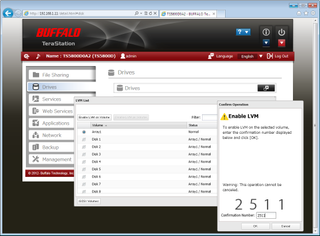IT Pro Verdict
The TeraStation TS5800 is much faster than its predecessor and scores well for value. NAS and IP SAN integration is long overdue but very welcome and general data backup features are good. However, if you want a lot more for your money then check out Qnap’s and Synology’s 8-bay appliances.
Buffalo has always persisted in offering separate NAS and IP SAN appliances but the new TeraStation TS5000 series finally brings the two together in a single appliance. The family consists of four models with the TS5800 on review offering eight hot-swap drive bays.
It uses the same chassis as the older TeraStation 8-bay which we found well built and quiet. On review is the 8TB model which comes with a full house of 1TB WD GreenPower SATA hot-swap hard disks.
Buffalo still doesn't offer diskless models but 16TB, 24TB and 32TB capacities are available. If a drive fails you must get your replacements from Buffalo.

To use combined NAS and IP SANs you need the enable Buffalo's LVM feature on the RAID array first
Installation
Buffalo's NASNavigator 2 streamlines installation and provides quick access to the appliance's web interface, network shares and a drive mapping service. The web interface sees a substantial redesign making it easier to use and it's more responsive than previous versions.
RAID options are plentiful and the appliance comes preconfigured as a single RAID-5 array. If you want RAID-6 and are prepared to take the hit on reduced capacity you can easily delete the default array and create a new one.
You can have multiple arrays as the TS5800 supports up to four and you can set one drive aside as a hot spare. Buffalo's Media Cartridge option also lets you use one internal hard disk as removable media.

Multiple NAS volumes can be created using the LVM feature and each one can be expanded into spare space on demand
LVM decisions
Before creating shares you need to think about how you want to present your storage. To implement IP SAN support, Buffalo ported over the software components from its TeraStation iSCSI appliance which employs the LVM (logical volume manager) feature.
By default, the TS5800 is preconfigured with LVM disabled on its RAID-5 array. This supports a single logical volume which can be used for NAS shares or one large IP SAN volume but not both together.
LVM allows multiple NAS and IP SAN volumes to exist in the same RAID array but enabling it will delete any pre-existing shares. Likewise, disabling LVM on the array will also delete any shares and IP SAN targets.
For network shares you first need to create NAS volumes in the LVM enabled array. These can be any size up to the maximum available and a handy feature is the ability to expand them into free space on demand.

The bundled NovaBackup software is licensed for ten users and provides good workstation backup facilities
Dave is an IT consultant and freelance journalist specialising in hands-on reviews of computer networking products covering all market sectors from small businesses to enterprises. Founder of Binary Testing Ltd – the UK’s premier independent network testing laboratory - Dave has over 45 years of experience in the IT industry.
Dave has produced many thousands of in-depth business networking product reviews from his lab which have been reproduced globally. Writing for ITPro and its sister title, PC Pro, he covers all areas of business IT infrastructure, including servers, storage, network security, data protection, cloud, infrastructure and services.

